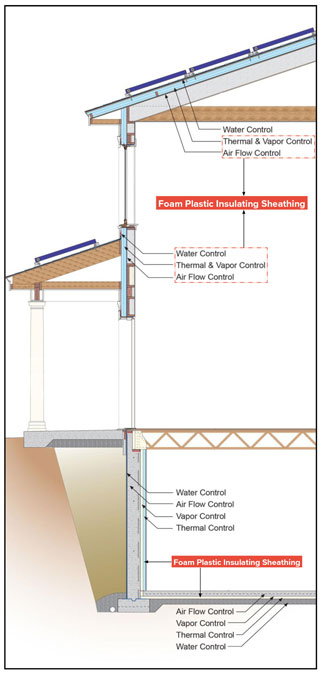Understand the Advantages of Using Foam Plastic Insulating Sheathing (FPIS) Continuous Insulation (ci)
Continuous insulation is used on foundations, exterior walls, and roofs. FPIS ci is an extremely versatile product that allows users to:
Multitask
FPIS has a variety of applications (continuous insulation, water-resistive barrier, air barrier, etc.) for walls, floors, roofs, and foundations in both commercial and residential buildings.
Save Money
FPIS is a cost-effective insulation due to its high R-value per inch and multiple benefits. The investment in applying FPIS as continuous insulation returns value throughout its use with reduced energy requirements and better building performance. It can even reduce construction time and related costs in applications such as frost-protected shallow foundations.

Conserve Energy
FPIS improves building thermal performance, reduces thermal bridging, and has been approved for use as an air barrier when joints are properly sealed.
Increase Durability
FPIS is moisture-resistant and helps defend against the damaging effects of moisture in buildings.
Improve Health in Indoor Environments
When coupled with good HVAC system design, applying FPIS can reduce health threats and support well-being for those living or working in the building.
Support Renewable Energy and Net-Zero Construction
FPIS enables the efficient use of on-site (roof solar panels) or off-site renewable energy sources to reduce or eliminate dependency on fossil fuels and help enable a net zero building.

Reduce Carbon Footprint
FPIS supports sustainability goals by significantly decreasing a building’s operational carbon overall effects on the environment for the entire life span of the building.
Boost Resiliency
FPIS helps create a building envelope that is more flood resistant and maintains provides better shelter-in-place temperatures in extreme weather conditions.

Maximize Comfort
FPIS helps moderate the indoor temperatures to provide a more comfortable environment for those using the space.

Image Source: NIST Technical Note 1847, Design Challenges of the NIST Net Zero Energy Residential Test Facility, by Betsy Pettit, Cathy Gates, A. Hunter Fanney, and William M. Healy.
Explore Applications of FPIS ci Download FACTS Sheet Read Case Studies
While the options and opportunities are significant, the application must also accommodate cladding installation, fire performance requirements, and other matters important to overall constructability and code compliance. For more information on individual FPIS products, visit members of the Foam Sheathing Committee (FSC) of the American Chemistry Council.
Additional Resources:
- Continuous Insulation: Research, Applications & Resources for Walls, Roofs & Foundations
This presentation addresses these topics based on a comprehensive body of building science knowledge resulting in recent building code and energy code advancements and makes use of many technical resources found on this website. -
Continuous Insulation Resource Guide
A collection of helpful FACTS Sheets and Quick Guides for code-compliant applications of foam plastic insulating sheathing (FPIS).